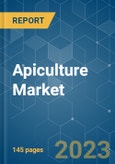The global apiculture market is estimated to register a CAGR of 4.3% during the forecast period.
This product will be delivered within 2 business days.
Key Highlights
- Commercial beekeeping farming will come into the picture as the demand for apiculture products from various industries increases due to medicinal and cosmetic purposes, further driving the apiculture market. The benefits associated with apiculture rearing are low maintenance and cost-effectiveness.
- The increasing demand for honey, beeswax, and other byproducts in developing countries is expected to boost the global market during the forecast period. Europe and North America have a significant consumption share of products like propolis, honey, and other products, while rapid growth has been projected in the Asia-Pacific regions. Support for organic agriculture has been rising, with many organizations like National Beekeepers Association and the National Organic Value chain Association extending their support toward organic agriculture. This trend has led to a rise in pollination demand, which boosts the apiculture market.
- Consumers have become more health conscious; many customers are demanding more natural sweeteners like honey than sugar. Honey is considered a healthier way to sweeten food and beverages as honey contains about 75-80% sugar, and the rest is a mixture of water and minerals like phosphorous, calcium, magnesium, some acids, and enzymes. Therefore, health benefits associated with honey are expected to increase the demand for honey in the global market.
- Artificial sweeteners may result in obesity, elevated cholesterol, mineral depletion, tooth decay, hypertension, and cardiovascular diseases. These sweeteners are also responsible for Type 2 diabetes, metabolic syndrome, cancers, and tumors. On the other hand, honey has a low glycemic index (GI), meaning it does not immediately elevate blood sugar levels. It's also high in antioxidants, which have numerous human health benefits.
- Additionally, propolis is a resinous substance that bees accumulate from different plant types. Propolis is widely used in numerous applications due to its antiseptic, anti-inflammatory, antioxidant, antifungal, anti-cancer, and immunomodulatory properties. However, the market is primarily driven by its use as a healing product for cold sores and herpes caused due to the herpes simplex virus (type 1 and type 2). The wide range of applications of apiculture products has been driving the market studied.
Apiculture Market Trends
Honey Emerges As a Functional Sweetener
- Honey has been advocated as a substitute for sugar, with more people accepting it and including it in their diets. Moreover, the use of products like beeswax, honey, and other such products is being increasingly utilized in the cosmetics and medical industry, further spearheading the growth of the global apiculture market.
- Further, manuka honey is gaining popularity across the globe on account of its antibacterial, anti-inflammatory, and antimicrobial properties. Honey consumption as an artificial sweetener by various industries is boosting the growth of the global apiculture market.
- Additionally, apiculture-based in the cosmetics and medicines industry is expected to increase further during the forecast period. According to the United States Department of Agriculture, the value of honey production in the United States in 2021 was roughly USD 321.22 million.
Asia-Pacific Leads the Global Apiculture Market
- The Asia-Pacific region had the largest market share in the apiculture market. China is the biggest honey manufacturer in the world. China is the world's largest country for beekeeping, honey production exporter, and honey consumption. China exports honey and apiculture-based products, including propolis, in Europe, the United States, and other Asian countries, like Japan.
- According to the UN Comtrade data, Japan's imports of live bees and insects were valued at USD 5.2 million in the year 2021. This implies the growth of apiculture-based products in the country has been increasing. Many other developing countries lack the infrastructure required to perform apiculture, making the region dominant in the market. The consumption of apiculture products like health supplements, beeswax-based medicines, and cosmetics, honey is increasing in Asia-Pacific due to the health benefits.
- Apiculture products' application as a health care product has been gaining popularity in the studied market, as it helps to heal burns, prevent dental cavities, and treat gingivitis. Also, it is used as a mouth disinfectant. It may also eliminate parasites, remove warts, and is more effective than the pharmaceutical drug to treat genital herpes.
- Additionally, the chemical-free product has been gaining popularity as a natural balm throughout the Asia-Pacific region due to its distinctive texture, best described as 'gunk.' This texture results from the mixture of pine resin, wax flakes, and pollen that bees collect and bring to the hive, where consumers buy the product in convenient small bottles.
Apiculture Market Competitor Analysis
The apiculture market is fragmented, with many beekeeping firms in different regions across the globe. The major players focus on strategic planning to grow the business portfolio. Apart from business development activity, the acquisition is also considered for business growth to improve the market share. Major players like Clearskys, Arnold honey bee services, Beeswax From Beekeepers, Millers Honey, and Burleson's Honey are making strategic moves to make their businesses grow.Additional benefits of purchasing the report:
- The market estimate (ME) sheet in Excel format
- 3 months of analyst support
This product will be delivered within 2 business days.
Table of Contents
1 INTRODUCTION
4 MARKET DYNAMICS
5 MARKET SEGMENTATION
6 COMPETITIVE LANDSCAPE
Companies Mentioned (Partial List)
A selection of companies mentioned in this report includes, but is not limited to:
- Betterbee
- Beeswax From Beekeepers
- Miller’s Honey
- Clearskys
- Bartnik LLC
- Beehive Botanicals
- EURL Atlantic Apiculture
- Arnold honey bee services
- Pastili Limited
- PhytoPharma International Ltd. (Bee-Fuse Technology)
Methodology

LOADING...










